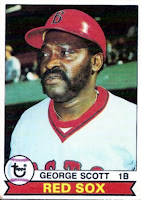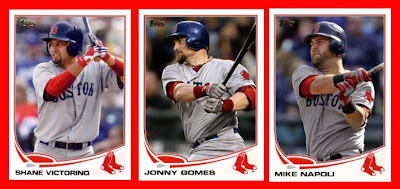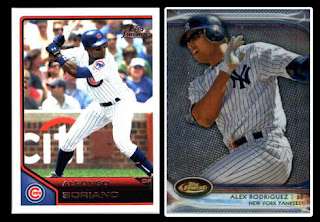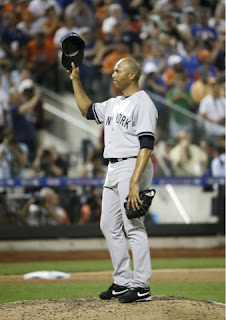We just lost The Boomer...sad, sad, sad...George Scott passed away today. The original Big PapiNow to be totally honest, I had heard of the name George Scott but was really unfamiliar with him. I decided to look into him and see what man known as the Boomer was about.
George Scott was a powerful slugger and prodigious fielder in his day who liked to refer to his homers as "Taters" and called his glove "Black Beauty". Scott was called up to the Red Sox in 1966 and immediately made his presence felt in the league by playing every game in the season and putting up an impressive rookie season of .245 with 27 homeruns and 90 RBI with 147 hits (18 2B/7 3B/27 HR) and an OPS of .757 (.324 OBP/.433 SLG). He was the starting first baseman for the American League and ended up tied for third in the 1966 American League Rookie of the Year behind Tommie Agee of the Chicago White Sox, Jim Nash of the Kansas City Royals and Davey Johnson of the Baltimore Orioles.
Scott was a pivotal player on the 1967 Red Sox team that is affectionately known as "The Impossible Dream". Playing alongside Carl Yaztremski, Tony Conigliaro, Reggie Smith, Mike Andrews, Jim Lonborg, Jerry Adair, and Joe Foy the Boston Red Sox returned to the World Series with a 90-72 record under Manager Hall of Famer Dick Williams. It was the Red Sox's first World Series appearance since 1946. The Red Sox would lose a close series to the St. Louis Cardinals who was led by Hall of Famer Bob Gibson who was the MVP of the World Series with three complete game victories against the Red Sox, two of which were shutouts.
 |
| 1967 Boston Red Sox Autographed 35th Anniversary Poster Created by Renowned Artist Paul Madden |
Listed at 6 feet 2 inches and 210 pounds, Scott was evidently well over that, to the consternation of Dick Williams, the manager of the ’67 Sox.Not only was he agile on the base paths, but he was also nimble in the field. According to Nick Cafaldo in his article George Scott was a big man with a gentle way: ‘Boomer’ leaves a big void from the Boston Globe website dated July 29, 2013:
I have never seen a better-fielding first baseman. George Scott played first like Ozzie Smith played shortstop and like Brooks Robinson played third base...He had quick, soft hands and amazing footwork for such a large man.Scott would end up finishing 10th in the 1967 American League voting and won the first of his eight gold gloves. Scott would continue to hit "taters" to the delight of the Boston faithful until the day that I would assume Boston fans hated especially those who rooted for Scott. On October 10, 1971 the Red Sox made a deal with the Milwaukee Brewers to trade Scott with Ken Brett, Billy Conigliaro, Joe Lahoud, Jim Lonborg and Don Pavletich for Pat Skrable, Tommy Harper, Lew Krausse and Marty Pattin. It was in Milwaukee that Scott really hit his stride.
In five seasons with the Brew Crew would average .283 BA with 23 homers and 93 RBI with 170 hits (27 2B/4 3B/ 23 HR) and an OPS of .798 (.342 OBP/.456 SLG). His best season came in 1975 when he tied for the league lead in homeruns (with Reggie Jackson of the Oakland A's) with 36 "taters" and lead the league in RBI with 109. He was an All-Star, finished eight in the AL MVP voting and won the fourth of his consecutive five Gold Gloves while with the Brewers.
Scott would be traded back to the Boston Red Sox on December 6, 1976 with Bernie Carbo for Cecil Cooper. Scott would make his final All-Star appearance in 1977 and would eventually be traded to the Kansas City Royals on June 13, 1979 for Tom Poquette. He would be released from the Royals two months later, signing with the New York Yankees where he played out the rest of the season and retiring after being granted free agency at the end of the season.
Going back to Barry's statement of Scott being the original Big Papi. According to Red Sox historian Dick Bresciani in the article George Scott, 'Boomer,' dies at 69; starred for Pittsfield and Boston Red Sox from the Berkshire Eagle website dated July 29, 2013:
In losing George Scott, we have lost one of the most talented, colorful, and popular players in our history...He had great power and agility, with a large personality and a large physical stature. He could light up a clubhouse with his smile, his laugh, and his humorI can see the similarities with Ortiz and also Mo Vaughn. All three were big guys who radiated positive vibes while playing in Boston becoming fan favorites of the Red Sox nation. May He Rest in Peace.
Here is the career line for George Scott who played in 14 seasons from 1966-1979:
| Player | G | AB | R | H | 2B | 3B | HR | RBI | BB | SO | SB | CS | OBP | SLG | AVG | OPS | ||
|---|---|---|---|---|---|---|---|---|---|---|---|---|---|---|---|---|---|---|
| George Scott | 2034 | 7433 | 957 | 1992 | 306 | 60 | 271 | 1051 | 699 | 1418 | 69 | 57 | .333 | .435 | .268 | .767 |
Thanks Uncle B for turning me on to George Scott. Always like to hear about players who do well, especially one of us big guys.
Sisco Kid
For Further Reading:











